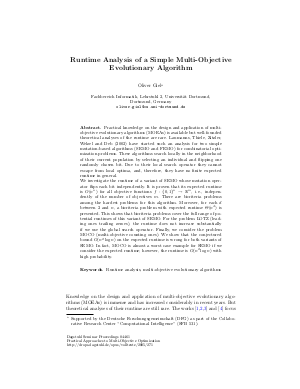Runtime Analysis of a Simple Multi-Objective Evolutionary Algorithm
Author Oliver Giel
-
Part of:
Volume:
Dagstuhl Seminar Proceedings, Volume 4461
Part of: Series: Dagstuhl Seminar Proceedings (DagSemProc) - License:
 Creative Commons Attribution 4.0 International license
Creative Commons Attribution 4.0 International license
- Publication Date: 2005-11-10
File

PDF
DagSemProc.04461.19.pdf
- Filesize: 137 kB
- 4 pages
Document Identifiers
Subject Classification
Keywords
- Runtime analysis
- multi-objecive evolutionary algorithms
Metrics
- Access Statistics
-
Total Accesses (updated on a weekly basis)
0Document
0Metadata
Abstract
Practical knowledge on the design and
application of multi-objective evolutionary
algorithms (MOEAs) is available but well-founded
theoretical analyses of the runtime are rare.
Laumanns, Thiele, Zitzler, Welzel and Deb (2002)
have started such an analysis for two simple
mutation-based algorithms including SEMO.
These algorithms search locally in the
neighborhood of their current population by
selecting an individual and flipping one
randomly chosen bit. Due to its local search
operator, SEMO cannot escape from local optima,
and, therefore, has no finite expected runtime
in general.
In this talk, we investigate the runtime of
a variant of SEMO whose mutation operator
flips each bit independently. It is proven
that its expected runtime is O(n^n) for all
objective functions f: {0,1}^n -> R^m, and
that there are bicriteria problems among the
hardest problem for this algorithm. Moreover,
for each d between 2 and n, a bicriteria
problem with expected runtime Theta(n^d) is
presented. This shows that bicriteria problems
cover the full range of potential runtimes of
this variant of SEMO. For the problem LOTZ
(Leading-Ones-Trailing Zeroes), the runtime
does not increase substantially if we use the
global search operator. Finally, we consider
the problem MOCO (Multi-Objective-Counting-Ones).
We show that the conjectured bound O((n^2)log n)
on the expected runtime is wrong for both
variants of SEMO. In fact, MOCO is almost a
worst case example for SEMO if we consider
the expected runtime; however, the runtime is
O((n^2)log n) with high probability. Some
ideas from the proof will be presented.
Cite As Get BibTex
Oliver Giel. Runtime Analysis of a Simple Multi-Objective Evolutionary Algorithm. In Practical Approaches to Multi-Objective Optimization. Dagstuhl Seminar Proceedings, Volume 4461, pp. 1-4, Schloss Dagstuhl – Leibniz-Zentrum für Informatik (2005)
https://doi.org/10.4230/DagSemProc.04461.19
BibTex
@InProceedings{giel:DagSemProc.04461.19,
author = {Giel, Oliver},
title = {{Runtime Analysis of a Simple Multi-Objective Evolutionary Algorithm}},
booktitle = {Practical Approaches to Multi-Objective Optimization},
pages = {1--4},
series = {Dagstuhl Seminar Proceedings (DagSemProc)},
ISSN = {1862-4405},
year = {2005},
volume = {4461},
editor = {J\"{u}rgen Branke and Kalyanmoy Deb and Kaisa Miettinen and Ralph E. Steuer},
publisher = {Schloss Dagstuhl -- Leibniz-Zentrum f{\"u}r Informatik},
address = {Dagstuhl, Germany},
URL = {https://drops.dagstuhl.de/entities/document/10.4230/DagSemProc.04461.19},
URN = {urn:nbn:de:0030-drops-2711},
doi = {10.4230/DagSemProc.04461.19},
annote = {Keywords: Runtime analysis, multi-objecive evolutionary algorithms}
}
